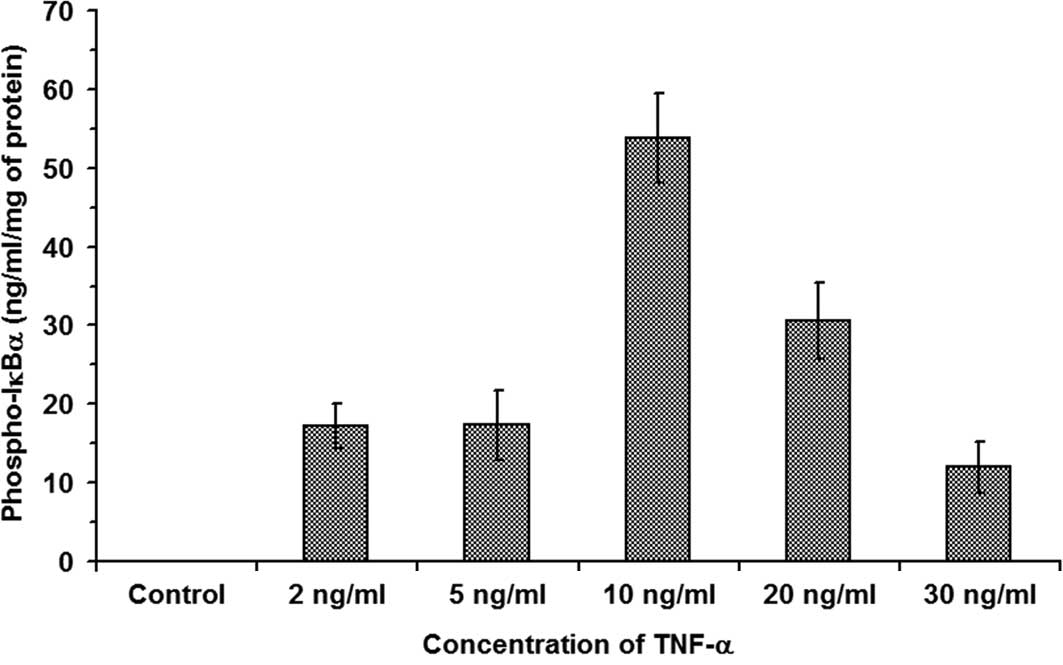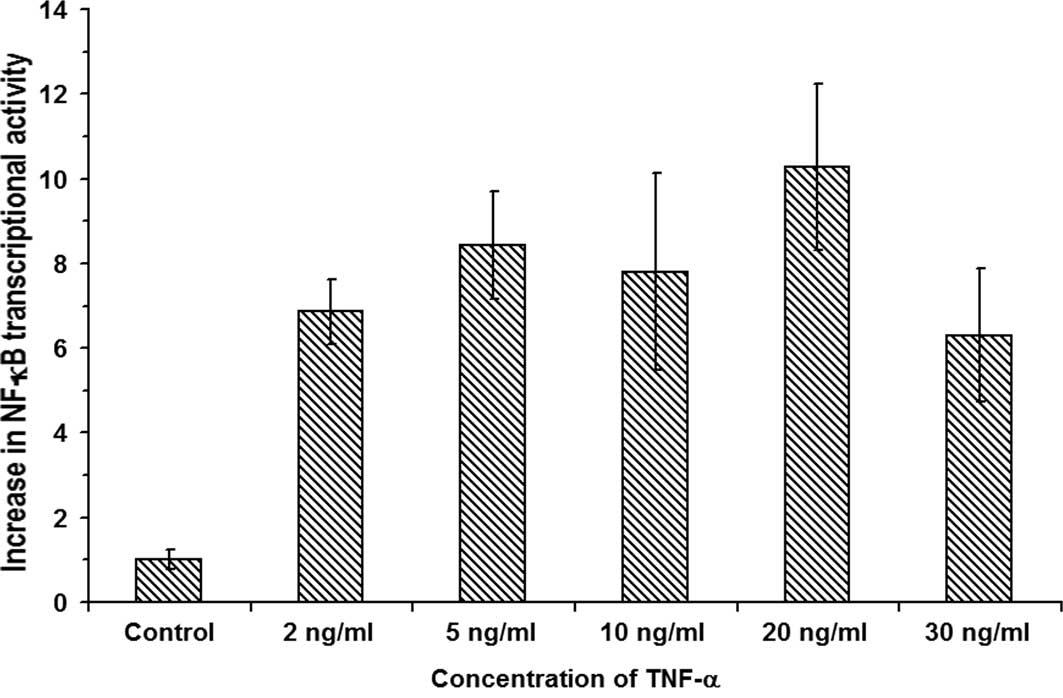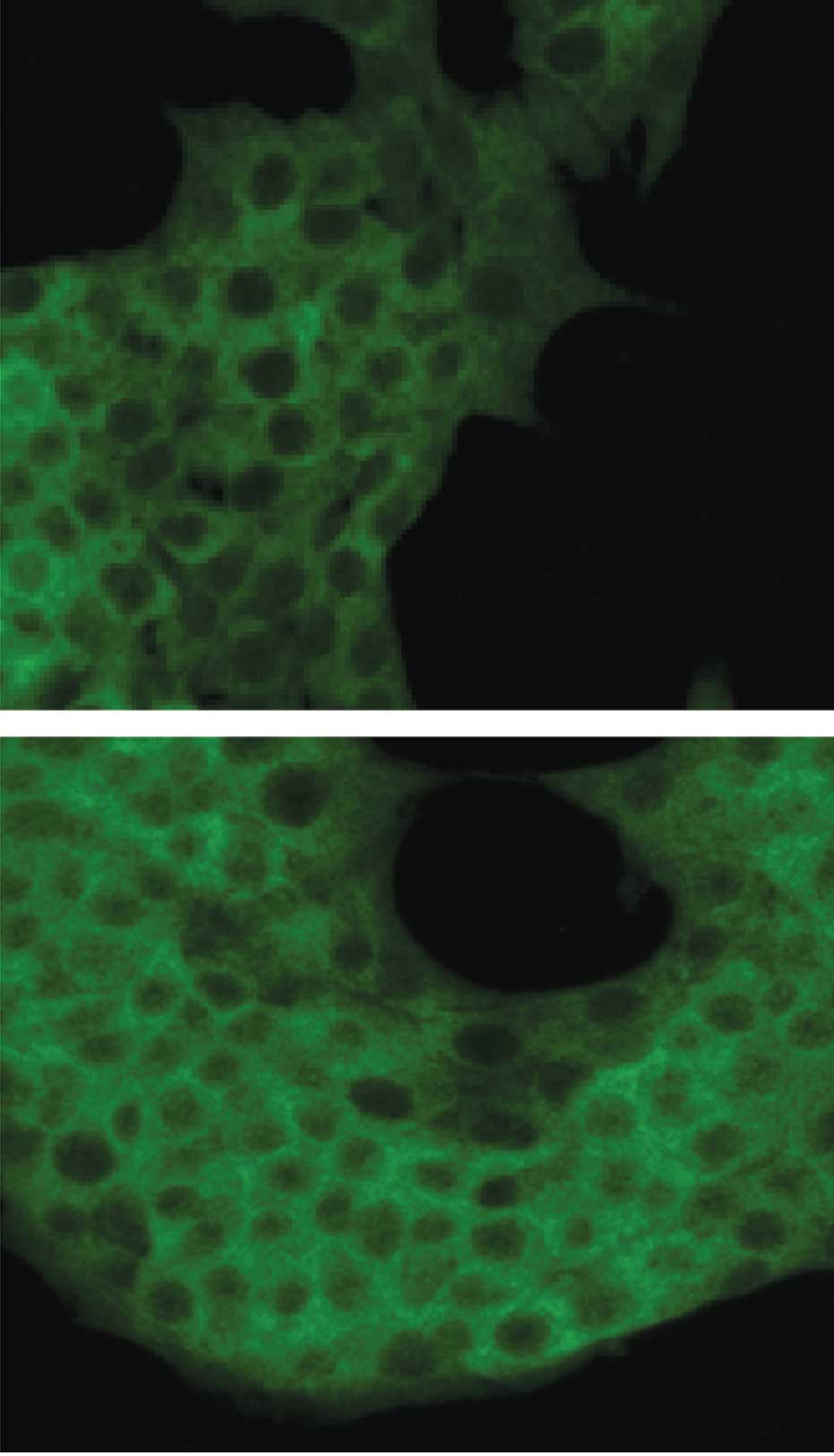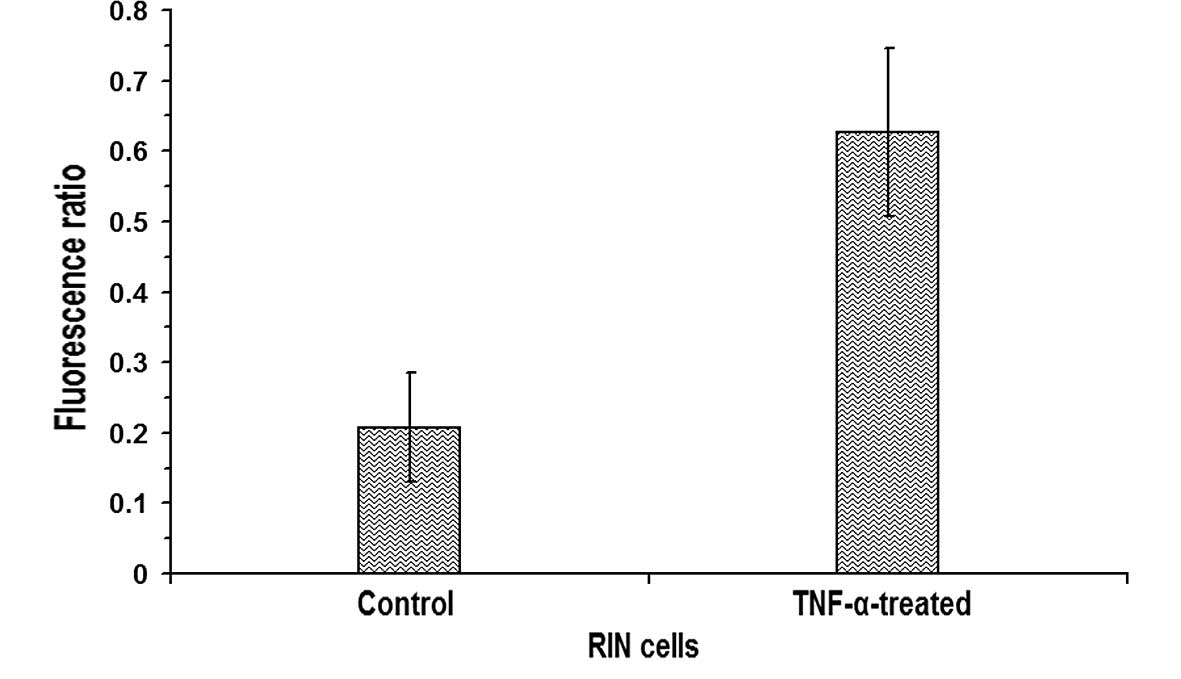Tumor necrosis factor-α induces transcriptional activation of nuclear factor-κB in insulin-producing β-cells
- Authors:
- Published online on: October 27, 2010 https://doi.org/10.3892/etm.2010.161
- Pages: 21-26
Abstract
Introduction
Failure of insulin-producing β-cells is a common feature of type 1 and type 2 diabetes mellitus. Anti-β-cell autoimmune reactions and associated inflammation lead to β-cell death in type 1 diabetes, whereas in type 2 diabetes the metabolic disorders produce inflammatory mediators in insulin-sensitive tissues leading to elevated levels of circulating inflammatory mediators, such as interleukin-6 and tumor necrosis factor-α (TNF-α) (1,2).
Cytokines, such as TNF-α, induce β-cell apoptosis through the induction of signaling pathways that activate nuclear factor-κB (NF-κB) (1–5). In rat-insulinoma (RIN) cells, which are an insulin-producing transformed β-cell line, it was shown, by measuring intracellular calcium [Ca2+]i and Ca2+ buffering capacity, that exposure of RIN cells to TNF-α caused dysregulation of [Ca2+]i (6). It was also shown that TNF-α-induced dysregulation of [Ca2+]i arose from a decrease in the total content of the cytoplasmic calcium binding protein calbindin-D28k.
The objective of the present study was to test the hypothesis that TNF-α-induced dysregulation of [Ca2+]i in insulin-producing β-cells causes proteolytic degradation of IκBα and consequently leads to the transcriptional activation of NF-κB. The NF-κB heterodimer is localized in the cytoplasm in association with an inhibitory subunit (IκB or inhibitory κB) (7). Following elevation of [Ca2+]i, IκB is phosphorylated, targeting it for ubiquitination and subsequent proteolysis. This frees NF-κB to enter the nucleus to bind DNA and activate genes (8–10). A key function of IκB's association with NF-κB is therefore its prevention of DNA binding. It has been shown previously that the sensitivity of different transcription factors to [Ca2+]i oscillations is highly frequency-dependent (1,11).
Since at present it is not known how the dysregulation of [Ca2+]i caused by TNF-α modulates the activation of NF-κB, the focus of the present study was on the dysregulation of [Ca2+]i as a mediator of cytokine-induced NF-κB activation via degradation of IκBα (1,7,11–15). To test this hypothesis, RIN cells were treated with increasing concentrations of TNF-α, and the following were measured: i) the degradation of IκBα using a FunctionELISA protocol, ii) the translocation of NF-κB from the cytoplasm to the nucleus by immunofluorescence using an antibody directed against the p65 NF-κB subunit (16,17), and iii) NF-κB-dependent transcription based on the DNA binding activity of NF-κB determined using an ELISA-based kit (17). The results are discussed in light of the dysregulation of [Ca2+]i caused by TNF-α, which activates NF-κB in RIN cells (6).
Materials and methods
RINr 1046-38 (abbreviated as RIN, a rat insulinoma cell line) insulin-producing β-cells were kindly provided by Dr Bruce Chertow (Veterans Administration Medical Center, Huntington, WV, USA). RIN cells were grown on 25-mm diameter glass coverslips in 6-well culture plates in a 5% CO2 incubator at 37°C. The cell culture medium was RPMI-1640 supplemented with 10% (w/v) fetal bovine serum, 100 U/ml penicillin and 100 μg/ml streptomycin (6).
IκBα degradation in TNF-α-treated β-cells
Treatment with TNF-α. TNF-α initiates a signal transduction cascade that leads to the activation of the IκB kinase complex (7). This complex phosphorylates IκBα, which leads to the ubiquitination of IκBα and its subsequent degradation by the 26S proteosome (1,7,11). Thus, analysis of the phosphorylation state of IκBα provides a correlation to the activity of the IκB kinase complex, as well as the activation of NF-κB. The RIN cells were exposed to 2, 5, 10, 20 and 30 ng/ml of TNF-α at 37°C for 20 min.
Preparation of whole cell lysates. The β-cell lysates from the control and TNF-α-treated RIN cells were prepared by washing the cells twice with ice-cold PBS, followed by scrapping the β-cells using a scrapper and suspending the cells in 3 ml PBS. The cells were then centrifuged at 1,000 rpm for 10 min at 4°C. The pellet containing β-cells was incubated in a complete cell lysis buffer for 30 min at 4°C, followed by centrifugation at 14,000 × g for 20 min at 4°C. The supernatant containing the cell lysate was collected, aliquoted and stored at −80°C for further analysis. The total protein content was determined using a BCA protein assay protocol in a 96-well plate (Pierce; catalog no. 23225).
Determination of phosphorylated IκBα using the FunctionELISA procedure. Standard Phospho-IκBα solutions with concentrations ranging between 0.15 and 10 ng/ml in blocking buffer were prepared in a 96-well FunctionELISA IκBα plate from a stock solution provided by Active Motif according to the manufacturer's instructions (Active Motif, Carlsbad CA, USA). The cell lysates from the control and TNF-α-treated RIN cells were diluted to 1 mg protein/ml in blocking buffer, and 100 μl of the lysate was pipetted into each well. The FunctionELISA IκBα plate was sealed and incubated at 4°C for 4 h. The contents of the FunctionELISA IκBα plate were then removed by inverting the FunctionELISA IκBα plate, and the wells were washed four times with 250 μl of wash buffer/well. The stock IκBα-detecting antibody was diluted to 1:250 in blocking buffer. IκBα-detecting antibody (50 μl) was added to each well, and the plate was incubated at room temperature for 1 h. The detecting antibody was then removed from the FunctionELISA IκBα plate, and the plate was washed thoroughly four times in 250 μl of wash buffer/well.
The horseradish peroxidase (HRP)-conjugated secondary antibody was then diluted 1:1,000 in blocking buffer, and 50 μl of this diluted secondary antibody was added to each well. The FunctionELISA IκBα plate was incubated at room temperature for 1 h. Following this, the FunctionELISA IκBα plate was washed five times as described above. Freshly prepared HRP ELISA substrate solution (50 μl) was added to each well. The luminescence from each well of the 96-well ELISA plate was then immediately measured using a TECAN 96-well plate reader GENious Plus with Magellan version 6.5 software. The concentrations of phosphorylated IκBα were calculated from the standard graph obtained using Phospho-IκBα control solution provided by the manufacturer Active Motif (FunctionELISA™ IκBα for the detection and analysis of IκBα phosphorylation; catalog nos. 48005 and 48505).
Translocation of NF-κB from the cytoplasm to the nucleus
TNF-α-induced NF-κB activation and DNA binding in β-cells, as measured by translocation of NF-κB from the cytoplasm to the nucleus, were assessed by immunofluorescence using an antibody directed against the p65 NF-κB subunit as follows (17): the RIN cells were exposed to 10 ng/ml TNF-α for 6 h at 37°C; the control and TNF-α-treated RIN cells on 25-mm diameter glass coverslips were then fixed by adding Bouin; the fixed RIN cells were further treated with a primary antibody directed against the p65 NF-κB subunit, followed by treatment with Alexa Fluor 488-coupled fluorescent secondary antibody; the confocal fluorescence images were scanned on a Nikon TE2000U inverted fluorescence microscope equipped with a Nikon C1 laser scanning confocal microscope system; the ratio of fluorescence in the nuclei to that in the cytoplasm were calculated using Metamorph 6.1 software (Universal Imaging Corp., CA, USA).
Transcriptional activation of NF-κB
Transcriptional activation of NF-κB has been defined using several methods, including the use of NF-κB-dependent reporter assays and also a DNA binding assay (17–20). Active Motif recently introduced the ELISA-based kit to detect and quantify transcription factor NF-κB activation. Briefly, RIN cells were grown on a T75 culture flask in a 5% CO2 incubator at 37°C. The cell culture medium was RPMI-1640 supplemented with 10% (w/v) fetal bovine serum, 100 U/ml penicillin and 100 μg/ ml streptomycin. After 5 days of culture, the RIN cells were exposed to 2, 5, 10, 20 and 30 ng/ml TNF-α for 6 h at 37°C. The nuclear extracts from the control and TNF-α-treated RIN cells were prepared according to the manufacturer's protocol, and the procedure is briefly described below.
Preparation of nuclear extract. After treatment with TNF-α, the cell culture medium was removed from each flask, and the cells were washed thrice with ice-cold PBS buffer, scrapped with a scrapper and suspended in PBS buffer in 1.5-ml Eppendorf centrifuge tubes, followed by centrifugation at 500 rpm for 5 min at 4°C. The cell pellet was suspended in 1X hypotonic buffer as per the manufacturer's protocol. After 15 min of incubation at 4°C, 25 μl of detergent was added to each Eppendorf tube, followed by vortexing at high speed for 10 sec. The suspension was centrifuged at 14,000 × g for 30 sec at 4°C. The pellet containing the nuclear fraction was resuspended in complete lysis buffer by pipetting up and down and was vortexed for 10 sec followed by incubation for 30 min on ice on a rocking platform set at 150 rpm. The contents were vortexed for 10 sec and then centrifuged at 14,000 × g for 10 min at 4°C. The supernatant containing the nuclear fraction was aliquoted and stored at −80°C. The protein concentration of the nuclear extract was determined using the BCA assay as described above.
Detection and quantification of NF-κB transcriptional activity using ELISA. Complete Binding Buffer (30 μl) was added to each well of a TransAM NF-κB 96-well ELISA plate (Active Motif). Then, 20 μl of nuclear extract diluted in Complete Lysis Buffer to a final protein content of 5 μg was added to each well. For the blank well, only 20 μl of Complete Lysis Buffer was added. The positive control provided as Jurkat cell nuclear extract by the manufacturer (Active Motif) was also used. The 96-well plate was then covered with a sealing tape and incubated for 1 h at room temperature under mild agitation at 100 rpm on a rocking platform. Each well was then washed three times with 200 μl of 1X wash buffer, and the ELISA plate was inverted and tapped on an absorbent paper towel. NF-κB primary antibody (100 μl diluted 1:1,000) was added to each well, and the plate was incubated for 1 h at room temperature without agitation. The wells were then washed thrice with 200 μl of wash buffer.
HRP-conjugated secondary antibody (100 μl) was added to each well, and the plate was again incubated for 1 h at room temperature. The plate was washed four times with 200 μl of buffer/well. The colorimetric reaction was carried out by adding 100 μl of developing solution to each well followed by incubation for 5 min at room temperature. The reaction was stopped by adding 100 μl of stop solution to each well. The absorbance of each well was then read within 5 min at 450 nm, with a reference wavelength of 655 nm, on a Molecular Device Spectra Max 340 PC 96-well plate reader.
Data analysis
Data are presented as the means ± standard deviation for three individual experiments. One-way ANOVA was used, as well as the Student's t-test, to study the statistical significance of the data obtained from the control and TNF-α-treated RIN cells.
Results and Discussion
In β-cells, the uptake and metabolism of glucose lead to closure of ATP-sensitive K+ channels, depolarization of the plasma membrane and the subsequent influx of Ca2+ through voltage-gated calcium channels. The Ca2+ signal provided by this influx of Ca2+ is accompanied by the release of Ca2+ from the endoplasmic reticulum (21–23). The subsequent increase in [Ca2+]i is an important determinant for insulin granule exocytosis. Ca2+ signals in β-cells activate the transcription factor NF-κB involved in the regulation of the cell cycle and apoptosis (12,24).
Our long-term goal is to characterize changes in [Ca2+]i homeostasis as a mediator of cytokine-induced β-cell dysfunction in diabetes (6). RINr 1046-38 (RIN), insulin-producing β-cells that constitutively express calbindin-D28k, have been previously used to characterize the effect of TNF-α on [Ca2+]i homeostasis, apoptosis, replication, insulin release and gene and protein expression (6). In its inactive form, NF-κB consists of a three-subunit complex consisting of two (prototypical) subunits of 50 kDa (p50) and 65 kDa (p65; RelA) and an IκB subunit (IκBα or IκBβ) (7). Following [Ca2+]i elevation, IκB is phosphorylated, targeting it for ubiquitination and subsequent proteolysis without affecting the integrity of the bound NF-κB dimer (24,25). The liberated NF-κB dimer is capable of binding DNA and activating genes (10). A key role of the IκB association with NF-κB is therefore its prevention of DNA binding (10,26).
In light of the discussion provided here, the aim was to ascertain whether, in insulin-producing β-cells, the dysregulation of [Ca2+]i by TNF-α leads to the transcriptional activation of NF-κB. To test this hypothesis, the experiments were designed and carried out as described above and the results are described and discussed as follows.
IκBα degradation in TNF-α-treated β-cells
Activation of the IκB kinase complex, which is located in the cytoplasm and involved in the phosphorylation of IκBα, occurs due to the binding of TNF-α to the TNF-α receptor located on the plasma membrane, which in turn initiates a cascade of signal transduction events (7). The activated IκB kinase complex phosphorylates IκBα, which is then followed by the ubiquitination of IκBα and its subsequent degradation by the 26S proteosome (1,7,11). Hence, analysis of the phosphorylation state of IκBα provides a correlation to the activity of the IκB kinase complex, as well as the activation of NF-κB.
The effects of TNF-α on the degradation of the IκBα subunit were examined. RIN cells were treated with increasing concentrations of TNF-α ranging between 2 and 30 ng/ml at 37°C for 20 min. The results are shown in Fig. 1 and indicate that, while in control RIN cell lysate there was no Phospho-IκBα present, thereby indicating the absence of degraded IκBα, in RIN cells exposed to 2, 5, 10, 20 and 30 ng/ ml TNF-α, 17.176±2.85, 17.292±4.35, 53.77±5.63, 30.58±4.89 and 12±3.27 ng/ml Phospho-IκBα/mg of total cell protein was observed, respectively (n=3, P<0.05). These observations indicate that 10 ng/ml TNF-α caused a maximum increase in the degraded IκBα as measured by the Phospho-IκBα value of 53.77±5.63 ng/ml Phospho-IκBα/mg of total cell protein (n=3, P<0.05). The results also suggest that TNF-α-induced signal transduction in β-cells results in the activation of the IκB kinase complex.
Transcriptional activation of NF-κB
As mentioned above, TNF-α-induced IκBα phosphorylation results in its ubiquitination and subsequent proteolysis, and therefore frees the NF-κB heterodimer bound to the IκBα. The liberated NF-κB dimer is capable of binding DNA and activating genes. Transcriptional activation of NF-κB has been defined by several methods including the use of NF-κB-dependent reporter assays and also a DNA binding assay (18–20). Active Motif has introduced the first ELISA-based kit to detect and quantify transcription factor NF-κB activation. This kit contains a 96-well plate, to which an oligonucleotide containing an NF-κB consensus binding 5′-GGGACTTTCC-3′ site has been immobilized. The activated NF-κB contained in nuclear or whole-cell extracts specifically binds to this oligonucleotide. The primary antibodies used to detect NF-κB recognize an epitope on p65 that is accessible only when NF-κB is activated and bound to its target DNA. By using an antibody that is directed against the NF-κB p65 subunit, the NF-κB complex bound to the oligo nucleotide is detected. Addition of a secondary antibody conjugated to HRP provides a sensitive assay that is easily quantified by measuring the absorbance using a 96-well plate reader.
The transcriptional activation of NF-κB was measured by Active Motif's TransAM ELISA-based kit. As described above, the RIN cells were exposed to 2, 5, 10, 20 and 30 ng/ ml TNF-α for 6 h at 37°C. Our measurements of the transcriptional activity of NF-κB in the nuclear extracts of control and TNF-α-treated RIN cells as shown in Fig. 2 indicate that, upon treatment of RIN cells with 2, 5, 10, 20 and 30 ng/ml TNF-α, the relative increases in the NF-κB transcriptional activities were 6.86±0.76-, 8.42±1.27-, 7.8±2.32-, 10.28±1.96-and 6.3±1.57-fold, respectively (n=3, P<0.05). The data show a maximum 10.28±1.96-fold increase in NF-κB transcription activation in RIN cells treated with 20 ng/ml TNF-α (n=3). Therefore, the results indicate that indeed, in insulin-producing β-cells, the dysregulation of [Ca2+]i by TNF-α leads to the transcriptional activation of NF-κB.
Translocation of NF-κB from the cytoplasm to the nucleus
In its inactive form, NF-κB consists of a three-subunit complex consisting of two (prototypical) subunits of 50 kDa (p50) and 65 kDa (p65; RelA), and an IκB subunit (IκBα or IκBβ) (7). In the cytoplasm, the inactive NF-κB heterodimer with two protein subunits, p50 (molecular mass 50 kDa) and p65 (molecular mass 65 kDa), is bound to an IκB protein subunit (IκBα or IκBβ) (7). Activation of this inactive NF-κB complex by TNF-α or elevated [Ca2+]i through proteolysis degradation of IκBα allows the activated NF-κB to move freely between the cytoplasm and nucleus. Upon entering the nucleus, the activated NF-κB is capable of binding DNA and causes the transcriptional activation of several genes.
In insulin-producing β-cells, nuclear translocation of the activated NF-κB from the cytoplasm was measured by immunofluorescence confocal microscopy in conjunction with an antibody directed against the p65 NF-κB subunit. The confocal fluorescence images presented in Fig. 3 show the cytoplasmic and nuclear distribution of NF-κB fluorescence in the control (Fig. 3A) and TNF-α-treated (Fig. 3B) insulin-producing β-cells.
Subsequently, the ratio of fluorescence intensities in nuclear regions to cytoplasmic regions was calculated by drawing regions of interests in confocal images of control and TNF-α-treated β-cells using Metamorph 6.1 software (Universal Imaging Corp.). The ratio of fluorescence in the nuclei to that in the cytoplasm of the untreated RIN cells was 0.2078±0.0778 (n=11), whereas in RIN cells treated with 10 ng/ml TNF-α, the ratio was 0.6267±0.1186 (n=11), indicating a statistically significant increase (P<0.05) in the nuclear translocation of NF-κB in the TNF-α-treated RIN cells (Fig. 4). The results shown in Figs. 3 and 4 indicate that indeed, in insulin-producing β-cells, the dysregulation of [Ca2+]i by TNF-α leading to the transcriptional activation of NF-κB occurs due to the increased nuclear translocation of NF-κB.
To elucidate the structural and functional parameters that define the relationship between calcium and the activation of NF-κB, Lewis (11) and Dolmetsch et al (1) conducted experiments using a ‘calcium clamp’, and showed that the sensitivity of different transcription factors, including NF-κB to [Ca2+]i oscillations, is highly frequency-dependent. [Ca2+]i oscillations of different frequencies lead to the expression of different sets of genes, presumably as a consequence of their effects on the underlying transcription factors. By differentially controlling the activation of distinct sets of transcription factors and the expression of different genes, the [Ca2+]i oscillation frequency may direct cells along specific developmental pathways. The ability to decode [Ca2+]i oscillation frequencies results from the kinetics of transcription factor regulation.
In light of the observations presented above as well as those of previous studies, we conclude that the subcellular localization and kinetics of the Ca2+ signal affect how increases in [Ca2+]i induced by different physiological stimuli are translated into a specific cellular response. Additionally, it is likely that the spatiotemporal nature of β-cell Ca2+ signaling plays an important role in Ca2+-dependent NF-κB signaling (6,24).
Acknowledgements
This study was supported by an NIH/NIGMS grant to J.P. (award no. SC3GM084751). The content is solely the responsibility of the author and does not necessarily represent the official views of the National Institute of General Medical Sciences or the National Institute of Health.
References
|
Dolmetsch RE, Xu K and Lewis RS: Calcium oscillations increase the efficiency and specificity of gene expression. Nature. 392:933–936. 1998. View Article : Google Scholar : PubMed/NCBI | |
|
Donath MY and Halban PA: Decreased β-cell mass in diabetes: significance, mechanisms and therapeutic implications. Diabetologia. 47:581–589. 2004. | |
|
Donath MY, Storling J, Maedler K and Mandrup-Poulsen T: Inflammatory mediators and islet β-cell failure: a link between type 1 and type 2 diabetes. J Mol Med. 81:455–470. 2003. | |
|
Flodstrom M, Welsh N and Eizirik DL: Cytokines activate the nuclear factor κB (NF-κB) and induce nitric oxide production in human pancreatic islets. FEBS Lett. 385:4–6. 1996. | |
|
Sekine N, Ishikawa T, Okazaki T, Hayashi M, Wollheim CB and Fujita T: Synergistic activation of NF-κB and inducible isoform of nitric oxide synthase induction by interferon-gamma and tumor necrosis factor-alpha in INS-1 cells. J Cell Physiol. 184:46–57. 2000. | |
|
Parkash J, Chaudhry MA and Rhoten WB: Tumor necrosis factor-α-induced changes in insulin-producing β-cells. Anat Rec. 286A:982–993. 2005. | |
|
Hoffman A and Baltimore D: Circuitry of nuclear factor κB signaling. Immunol Rev. 210:171–186. 2006. | |
|
Dolmetsch RE, Lewis RS, Goodnow CC and Healy JI: Differential activation of transcription factors induced by Ca2+ response amplitude and duration. Nature. 386:855–858. 1997. View Article : Google Scholar : PubMed/NCBI | |
|
Hoffmann A, Levchenko A, Scott ML and Baltimore D: The IκB-NF-κB signaling module: temporal control and selective gene activation. Science. 298:1241–1245. 2002. | |
|
Lee SH and Hannink M: Characterization of the nuclear import and export functions of Ikappa B(epsilon). J Biol Chem. 277:23358–23366. 2002. View Article : Google Scholar : PubMed/NCBI | |
|
Lewis RS: Calcium oscillations in T-cells: mechanisms and consequences for gene expression. Biochem Soc Trans. 31:925–929. 2003. View Article : Google Scholar : PubMed/NCBI | |
|
Parnaud G, Hammar E, Ribaux P, Donath MY, Berney T and Halaban PA: Signaling pathways implicated in the stimulation of beta-cell proliferation by extracellular matrix. Mol Endocrinol. 23:1264–1271. 2009. View Article : Google Scholar : PubMed/NCBI | |
|
Parkash J, Chaudhry MA, Amer AS, Christakos S and Rhoten WB: Intracellular calcium ion response to glucose in β-cells of calbindin-D28k nullmutant mice and in βHC13 cells over-expressing calbindin-D28k. Endocrine. 18:221–229. 2002. | |
|
Parkash J, Chaudhry MA and Rhoten WB: Ca2+ sensing receptor activation by CaCl2 increases [Ca2+]i resulting in enhanced spatial interaction with calbindin-D28k protein. Int J Mol Med. 13:3–11. 2004. | |
|
Parkash J: Inflammatory cytokine signaling in insulin producing β-cells enhances the colocalization correlation coefficient between L-type voltage-dependent calcium channel and calcium-sensing receptor. Int J Mol Med. 22:155–163. 2008. | |
|
Cnop M, Welsh N, Jones JC, Jorns A, Lenzen S and Eizirik DL: Mechanisms of pancreatic β-cell death in type 1 and type 2 diabetes. Diabetes. 54:S97–S107. 2005. | |
|
Hammar EB, Irminger JC, Rickenbach K, Parnaud G, Ribaux P, Bosco D, Rouiller DG and Halban PA: Activation of NF-κB by extracellular matrix is involved in spreading and glucosestimulated insulin secretion of pancreatic beta cells. J Biol Chem. 280:30630–30637. 2005. | |
|
Bergmann M, Hart L, Lindsay M, Barnes PJ and Newton R: IκBα degradation and nuclear factor-κB DNA binding are insufficient for interleukin-1β and tumor necrosis factor-α-induced κB-dependent transcription. Requirement for an additional pathway. J Biol Chem. 273:6607–6610. 1998. | |
|
Hu Q, Deshpande S, Irani K and Ziegelstein RC: Ca2+ oscillation frequency regulates agonist-stimulated NF-κB transcriptional activity. J Biol Chem. 274:33995–33998. 1999. | |
|
Trushin SA, Pennington KN, Algeciras-Schimnich A and Paya CV: Protein kinase C and calcineurin synergize to activate IκB kinase and NF-κB in T lymphocytes. J Biol Chem. 274:22923–22931. 1999. | |
|
Ammala C, Larsson O, Berggren PO, Bokvist K, Juntti-Berggren L, Kindmark H and Rorsman P: Inositol trisphosphate-dependent periodic activation of a Ca2+-activated K+-conductance in glucose-stimulated pancreatic β-cells. Nature. 353:849–852. 1991. View Article : Google Scholar : PubMed/NCBI | |
|
Berggren PO and Larsson O: Ca2+ and pancreatic β-cell function. Biochem Soc Trans. 22:12–18. 1994. | |
|
Lemmens R, Larsson O, Berggren PO and Islam MS: Ca2+-induced Ca2+ release from the endoplasmic reticulum amplifies the Ca2+ signal mediated by activation of voltage-gated L-type Ca2+ channels in pancreatic β-cells. J Biol Chem. 276:9971–9977. 2001. | |
|
Bernal-Mizrachi E, Wen W, Shornick M and Permutt AM: Activation of nuclear factor-κB by depolarization and Ca2+-influx in MIN6 insulinoma cells. Diabetes. 51(Suppl 3): 484–488. 2002. | |
|
Claudio E, Brown K, Park S, Wang H and Siebenlist U: BAFF-induced NEMO-independent processing of NF-kappa B2 in maturing B cells. Nat Immun. 3:958–965. 2002. View Article : Google Scholar : PubMed/NCBI | |
|
Scott ML, Fujita T, Liou HC, Nolan GP and Baltimore D: The p65 subunit of NF-kappa B regulates I kappa B by two distinct mechanisms. Genes Dev. 7:1266–1276. 1993. View Article : Google Scholar : PubMed/NCBI |













